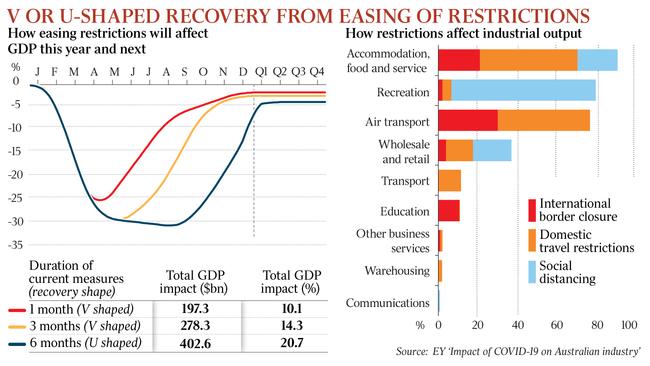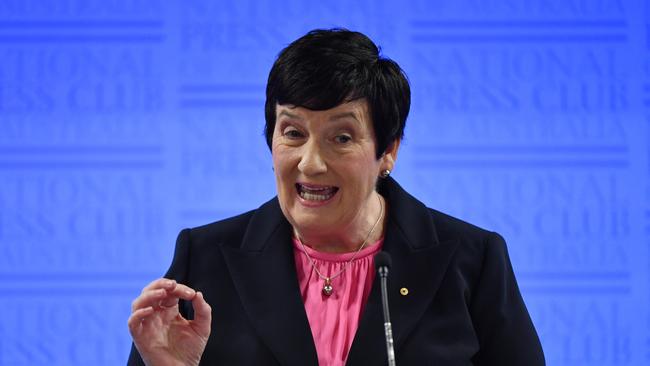Coronavirus Australia: Relaxation a tonic for economic recovery
Major reforms are needed to avoid consigning older workers to permanent unemployment as restrictions are eased.

The nation could sidestep economic catastrophe if COVID-19 restrictions are eased within weeks but will need to embrace sweeping economic reforms to avoid the risk of consigning a generation of older workers to permanent unemployment.
New modelling to be released by the Business Council of Australia estimates the impact of COVID-19 social distancing, border closures and business shutdowns at $200bn in the first month, rising to $280bn after three months and $400bn if the lockdown extends for six months.
The Ernst & Young modelling, to be released on Monday, shows the government would need to substantially lift restrictions by June to ensure a “V-shaped” economic recovery and reverse the huge employment stand-downs that have occurred over the past month. National cabinet is scheduled to begin debating the relaxation of restrictions in three weeks.
Until the government’s economic rescue package was handed down, the BCA found that the 40 per cent of workers most likely to enter the ranks of the long-term unemployed were the same group who never found work again after the recession of the early 1990s.

BCA chief executive Jennifer Westacott said those over 50 and people without qualifications beyond high school were “already at the highest risk of falling into long-term unemployment”.
“It’s important we do everything we can to make sure they are not left behind,” she said.
Laying out the BCA’s preliminary reform blueprint to kickstart the economic recovery, Ms Westacott also said Australia had a “once-in-a-generation opportunity to recraft the kind of society we want to be and the type of economy we need to achieve it”.
She is pushing for broadscale tax reform, the simplification of industrial awards, a faster upskilling of workers, better infrastructure, a rejuvenation of regional economies, effective commercialisation of new technologies and the slashing of red tape. “In resuscitating our economy, we can tackle some of our most vexed problems and social issues,” Ms Westacott writes in The Australian.
Without the government’s rescue package — $320bn in fiscal and monetary terms — the BCA argues that 2.3 million full-time workers would have lost their jobs and entire sectors left decimated, with accommodation and food losing 78 per cent of its workforce, retail losing 45 per cent, construction 29 per cent and manufacturing 36 per cent.
Ms Westacott said the nation was well placed to recover strongly with a plan to manage the virus, but argued the critical factor was how long restrictions remained.
“Whether that recovery takes a V or a U shape depends on how safely and quickly we ease restrictions,” she said. “When we are making decisions about our recovery we need to ask ourselves does this create a new job, a secure job, better paid job or does it get someone back to work?
“There can be no trade-off between the health, social and economic recovery, but older workers and those with high school or below education will pay the highest cost of failure on any front.”
With some corporate leaders calling for swifter relaxing of restrictions, modelling conducted for the BCA by accounting firm EY shows that a longer hibernation period — where restrictions are in place for six months — would cost the economy $402.6bn this year, equal to 20.7 per cent of GDP.
By contrast, a one-month hibernation period would cost the economy $197.3bn, the equivalent of 10.1 per cent of GDP and provide for a V-shaped recovery. Australia’s lockdown measures have already been in place for longer than this threshold, with pubs, clubs, cinemas, gyms and casinos shutting down on March 23 and international borders closing two days earlier.
A middle-ground approach in which restrictions are in place for three months was also modelled, with this strategy costing the economy $278.3bn (14.3 per cent of GDP) and still providing for a V-shaped recovery.
Writing in The Australian, Ms Westacott urges political leaders to “steer clear of ideological constraints” and “sidestep ruling things in and ruling things out” as Australia emerges from the pandemic.
Ms Westacott said tax reform was needed to ensure Australia was globally competitive, arguing for the nation to strive for a system that “rewards effort, serves as a magnet for capital, jettisons distorting, inefficient or incentive-sapping taxes, better positions us to embrace the digital economy, and solves our commonwealth and state funding issues”.
On skills, Ms Westacott said it was necessary to overhaul the system so workers could access “micro-credentials” allowing them to build their own qualifications more quickly than undertaking two- or three-year courses.
Another key priority for business was to “simplify the complex awards structure and restore faith in the enterprise bargaining system” — a task that will require input from companies and unions.
“On regulation, we should look at the measures that have been suspended during the COVID-19 crisis and ask whether we really needed them in the first place? … Why does it take so long to get a major project approved or do simple things such as housing construction?” Ms Westacott said.
“On infrastructure, we need to address how we fund the right enabling projects that will boost productivity by allowing us to move around faster, ease congestion, and more easily export our world-leading goods and produce.
“On our regions, we need to think about how we maximise their potential and nurture them as places of economic growth, whether that is centres of innovation and advanced manufacturing or our backbone industries of resources and agriculture.”
Modelling being released by the BCA also reveals the impact that the international border closure, domestic border closures and social-distancing measures have had on different industries.
The majority of the impact on industry is the result of domestic travel restrictions and social distancing, with the modelling suggesting these measures would be of the highest value to remove first.
Ms Westacott said that every dollar invested in energy “should be a dollar towards a lower carbon economy and lower cost energy bills”.
She said telecommunications and digital companies had given society the capacity to work from home while manufacturers had produced lifesaving equipment.








To join the conversation, please log in. Don't have an account? Register
Join the conversation, you are commenting as Logout